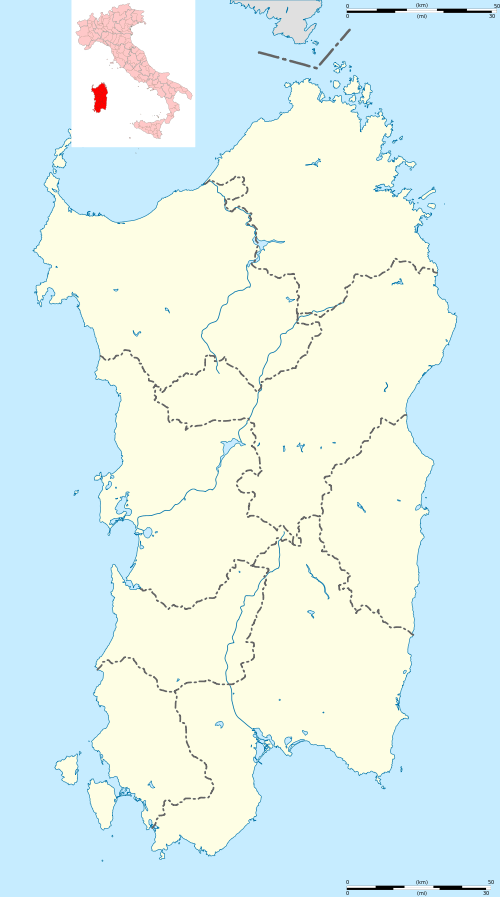Tharros
Coordinates: 39°52′24″N 8°26′23″E / 39.8733°N 8.43972°E
 View of Corinthian columns at Tharros | |
 Shown within Sardinia | |
| Type | Settlement |
|---|---|
| History | |
| Founded | Eighth century BCE |
| Cultures | Nuragic civilization, Punic civilization, Roman civilization |
| Site notes | |
| Condition | Ruined |
| Management | I Beni Culturali della Sardegna |
| Public access | Yes |
| Website | Cabras, area di Tharros (Italian) |
Tharros (also spelled Tharras, Greek: Θάρρας, Ptol., Tarrae or Tarras) was an ancient city on the west coast of Sardinia, Italy. It is currently an archaeological site near the village of San Giovanni di Sinis, municipality of Cabras, in the Province of Oristano. It is located on the southern shore of the Sinis peninsula, which forms the northern cape of the Bay of Oristano, by the cape of San Marco. Tharros, mentioned by Ptolemy and in the Itineraries, seems to have been one of the most important places on the island.
Foundation
Until some years ago, the archaeological findings in the area of Tharros supported the theory that Phoenicians founded the town in eighth century BC. The probability of this was reduced by the finding of some parts of the old settlement in the Mistras Lagoon. A submerged 100 m wall seems to be part of a port structure much older than the Phoenician one, since in 1200 BC sealevel rose, swallowing the existing buildings.[1] A previous nuragic settlement apparently existed there in the Bronze Age, as the nuragic presence near the tophet area seems to suggest.[2][3]
Thopeth
Archaeologists found a tophet, an open-air sacred place common for several installations of Phoenicians in the western Mediterranean, on top of a hill called Su Muru Mannu near the remains of a village built by the nuragic peoples (1900-730 BC[4]). This is seen as a first sign of colonization and urbanization.
Later history
Excavations showed that from the 8th century BC its abandonment in the 10th century Tharros was inhabited, first by Phoenicians, then by Punics and then by Romans. The town was the capital of the medieval Giudicato of Arborea, a Roman/Byzantine relict state from the 9th century until 1070 when Orzocorre I of Arborea relocated to Oristano under pressure of Saracen raiders. The town was effectively abandoned at this time or shortly thereafter. The site was then used for centuries as a quarry. An inscription records the repair of the road from Tharras to Cornus as late as the reign of emperor Philip.[5] The Antonine Itinerary correctly places it 18 miles from Cornus and 12 from Othoca (modern Santa Giusta near Oristano).[6] However, its history during most of the period of Roman domination or early Christianity is unknown.
Site
The area is now an open-air museum with active excavation sites. Among the interesting structures are the tophet, the bath installations, the temple foundations and an area with houses and artisan workshops.
Most of the artifacts can be found in the Archaeological Museum at Cagliari, in the Antiquarium Arborense, the Archaeological Museum of the town of Cabras and in the British Museum, London.[7]
Sources
- Acquaro, E.; C. Finzi (1986). Tharros. Sassari.
- Osborne R. and B. Cunliffe, ed. (2005). Mediterranean Urbanization 800-600 BC. New York.
External links
- Encyclopaedia Britannica 1911: "Tharros"
- On the prehistory and history of Sardinia, Tharros
-
 This article incorporates text from a publication now in the public domain: Smith, William, ed. (1854–1857). "article name needed". Dictionary of Greek and Roman Geography. London: John Murray.
This article incorporates text from a publication now in the public domain: Smith, William, ed. (1854–1857). "article name needed". Dictionary of Greek and Roman Geography. London: John Murray.
References
- ↑ Antonioli, Fabrizio; Orrù, Paolo; Porqueddu, Alessandro and Solinas, Emanuela, "Variazioni del livello marino in Sardegna durante gli ultimi millenni sulla base di indicatori geo-archeologici costieri." In L'Africa romana: trasformazione dei paesaggi del potere nell'Africa settentrionale fino alla fine del mondo antico: atti del 19. Convegno di studio, 16-19 dicembre 2010, Sassari, Italia. p. 2963-2971. Carocci editore, Rome: 2012.
- ↑ Zucca, Raimondo "Bronzi nuragici da Tharros" In La Sardegna nel Mediterraneo tra il secondo e il primomillennio a.C.: atti del II Convegno di Studi "Un millennio di relazioni fra la Sardegna ei Paesi del Mediterraneo", 27-30 novembre 1986, Selargius-Cagliari, Italia. p. 117-132. Cagliari: 1987.
- ↑ Zucca, Raimondo (2011). Tharros, Othoca e Neapolis. Porti e approdi antichi in Sardegna. Oristano. Archived from the original on April 9, 2016. Retrieved 9 April 2016.
- ↑ Depalmas, A. and R. T. Melis, "The Nuragic People: their settlements, economic activities and use of the land, Sardinia, Italy." In Landscapes and Societies: Selected Cases, Eds. Martini, I. P. and W. Chesworth. Springer Science+Business Media, New York: 2010.
- ↑ De la Marmora, Voy. en Sardaigne, vol. ii. pp. 359, 477.
- ↑ Itin. Ant. p. 84; Ptol. iii. 3. § 2.
- ↑ British Museum Collection
| Wikimedia Commons has media related to Tharros. |